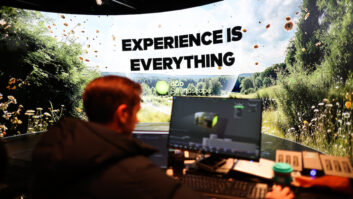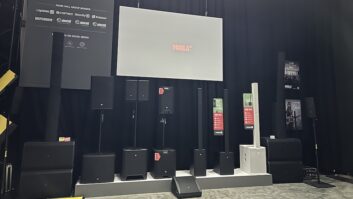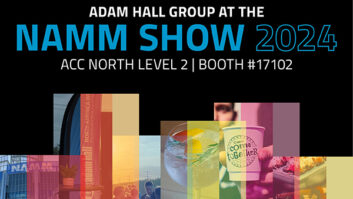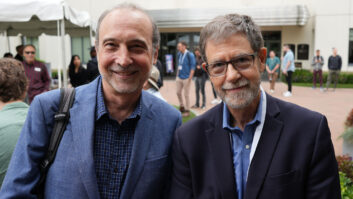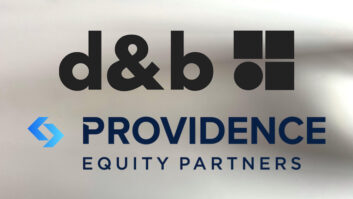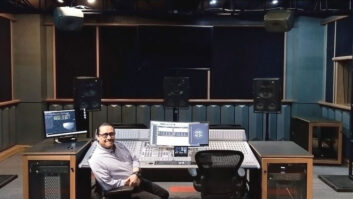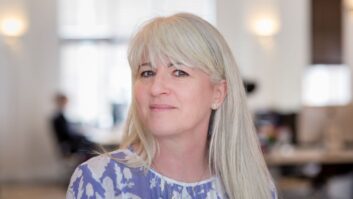Since Wave Group opened its Santa Clara, Calif., location in 1996, the company has morphed into a jack-of-all-trades for audio client services, handling everything including audio post-production, music recording, Foley recording and sound design for DVD menus. Two years ago, at the height of the dotcom boom, the company open-ed a satellite facility, tucked away in an nondescript industrial park in nearby Fremont.
The Fremont location had been home to studios for more than 10 years, most recently 911 Studios. When Wave Group moved in, they found that “the room was empty and pink,” says Wave Group senior engineer Sue Pelmulder with a laugh. “Essentially, we gutted it,” adds Wave Group president and owner Will Littlejohn. “There was no equipment, and it was pretty worn out.”
Wave Group started by talking about what they wanted to do in the facility before deciding how to outfit it. A number of other questions quickly followed, says Pelmulder, like: “How can we do that efficiently? How can we do that conveniently? How can we make it pleasant to look at? Really, what function does the room serve?”
“We also looked at the limitations of the space to begin with,” says Littlejohn. “Obviously, we’re not going to do any symphonies in the [live] room. We were looking at what our existing clients want, what other services we wanted to be able to provide, and started from there. We designed the facility from the need on back, rather than the other way around. Lots of folks throw in the neatest, latest stuff without really thinking about who they are working for.”
Before determining client needs and equipment choices, Littlejohn and Pelmulder took a hard look at the studio’s acoustics. “When we first walked in [the live] room without the acoustic treatments, you could hardly have a conversation,” she says. “I told [the ASC rep] that we didn’t want it dead, but we needed to be able to record two people talking to each other. It’s not just a music room.” Consequently, treatments were designed to handle bass and low-mid problems, while offering an even response without taking out the highs. ASC Studio Traps enabled them to fine-tune the room. In the voice-over booths, Pelmulder stood her ground for 3-inch sonic foam for even response. “Those rooms are not completely dead, but there is not an echo,” she says.
Once the live room was acceptable, Pelmulder got to work upgrading the studio. Because the Fremont location was a working studio during the day, she found the time — six months of soldering patchbays after-hours — to wire the entire facility to a new central machine room.
The machine room includes a pair of 20-bit Alesis ADATs and four Tascam DA-88s, in addition to Tascam MX-2424s. Wave Group also does a variety of Webcasting projects, so the machine room, which can be expanded in a snap, also includes a Gentner DH 10 and a Sony DVW A500 Digital Betacam.
For additional recording and editing, the team turned to a combination of Pro Tools and a Sony DMX-R100 console with four 8-channel AES/EBU cards. The key, says Littlejohn, was to remain flexible. “It was that old problem you have in studios: Do you want Pro Tools or do you want the board? We wanted a real board,” he says.
During a brainstorming session, Pelmulder came up with the idea of building an unconventional work surface, where either Pro Tools or the R-100 could be front and center. “We do a lot of voice-over work,” says Littlejohn. “We do a lot of work where there’s a lot of acquisition going on with a lot of people sitting around with laptops. So, you need a surface area for people to spread their stuff out on. We drew it out, and Sue, being an engineer, had a schematic of the work surface laid out a week later. She literally designed it from scratch, so it is a one-of-a-kind thing.”
Pelmulder worked with cabinet builder Dan Devoe to come up with a desk that can be rotated via dolly tracks. “It’s a flexibility thing,” Littlejohn says. “If you’re doing voice-over work, the Pro Tools station can be oriented toward the booth, or if you’re tracking in the live room and you want to do it through Pro Tools, you can do the rotation.” Pelmulder designed the system so nothing has to be turned off before or during the switch — it’s all in an S-Cable of audio and video that’s been anchored with strain relief.
Given the company’s assortment of work, deciding on Pro Tools was easy and, according to Pelmulder, so was picking out the R-100. “There’s a whole series of boards that are basically 48-in, but this one is sonically better and it has much nicer automation,” she says. “It is a little more expensive, but that $10,000 difference is worth it.” The board is stuffed with four AES cards, and all of the studio gear has been coupled with AES converters. “It sort of mirrors how we did the studio — any input can be assigned to any connector, any output can be assigned to any connector. So, if someone comes in and they have a DA-88 where they’ve tracked some stuff, and they’ve got some stuff in Pro Tools, you can just reassign,” she says.
Outboard equipment in Mix A includes API 3124 mic preamps, dbx 1066 compressor, Empirical Labs EL8, Eventide H3500, Lexicon PCM 70, Manley Massive Passive EQ, Oram Sonicomp 2 and Universal Audio 1170lm limiting amplifiers. Surround monitoring is provided by Genelec 1031s that are on stands and a pair of soffited Genelec 1032As. A Genelec 1094A handles the low end. In addition to the Pro Tools, two Tascam MX-2424s with 24 AES/EBU and 24 analog I/Os are used for recording.
Edit B, which is Littlejohn’s playroom, houses a Mackie D8B with four 8-channel AES/EBU cards, a Macintosh G4, and a bevy of instruments such as a Kurzweil K2500, Nord Modular, Roland JP8080, Roland V-Drums, Roland XV5080 and a Yamaha TG-500. Littlejohn has a penchant for changing his equipment on a day-to-day basis, so Pelmulder turned to stage boxes rather than access panels to wire the room. “I gave up trying to patch things,” Pelmulder says with a laugh. “That’s one thing I learned in the other facility. He’d come in and I’d ask him what he needed. He’d say, ‘The Nord, the 0V8 and the Kurzweil.’ I’d go in, get all the audio going and then I’d come back two days later. It would all be rearranged and half the things were unplugged. So, in the new facility, I put in stage boxes with MIDI, any kind of audio you want and a 16-channel balancing box in the rack so you can balance any of that old gear that’s unbalanced. It all goes into the patchbay.”
Edit C, which is used for audio jobs as well as Final Cut Pro Video editing, has a Mackie 1604 VLZ, a Macintosh G4 with Digi 001 and an Alesis M One.
“When it comes to the stuff that is in and around all the time, we have some real quality pieces, but just a few,” Littlejohn adds. “Some nice preamps, some nice outboard EQs, but not too many. We need good monitoring. We really love this board — it’s got EQs inside, it’s got nice dynamics inside — so a lot of what we do, we can do with just this equipment. For us, this is the type of business where you want to turn a profit. We’re very sensitive to having equipment that’s working all the time.”

